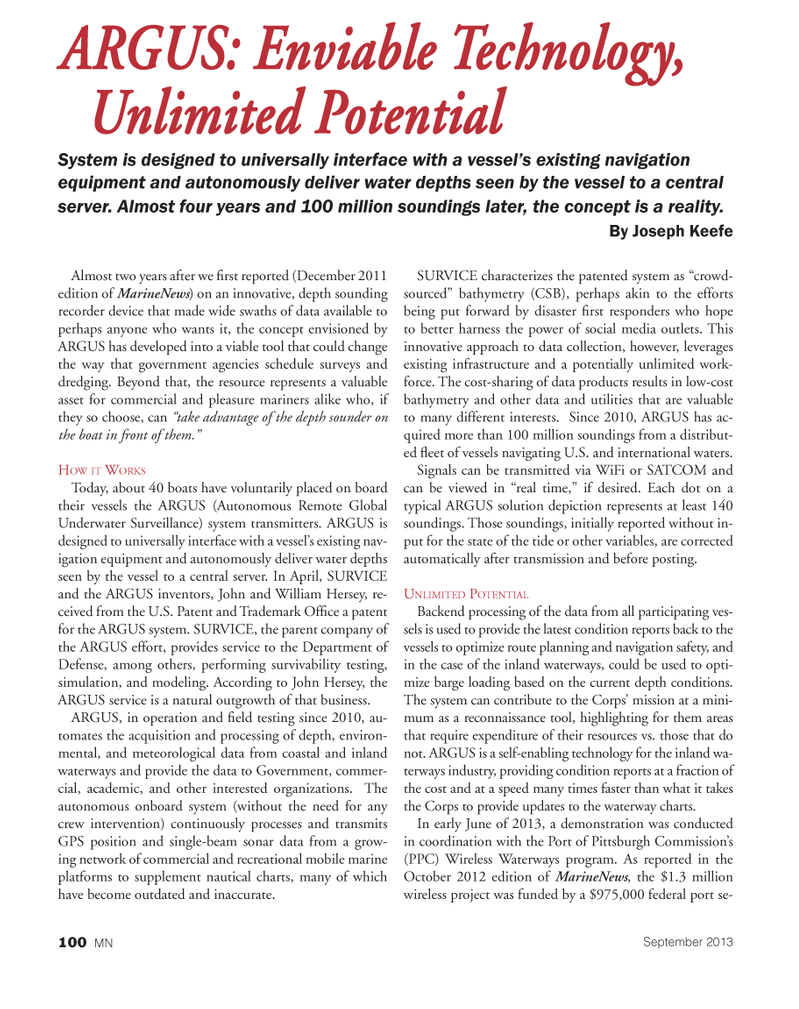
Page 100: of Marine News Magazine (September 2013)
Workboat Annual
Read this page in Pdf, Flash or Html5 edition of September 2013 Marine News Magazine
Almost two years after we ? rst reported (December 2011 edition of MarineNews ) on an innovative, depth sounding recorder device that made wide swaths of data available to perhaps anyone who wants it, the concept envisioned by ARGUS has developed into a viable tool that could change the way that government agencies schedule surveys and dredging. Beyond that, the resource represents a valuable asset for commercial and pleasure mariners alike who, if they so choose, can take advantage of the depth sounder on the boat in front of them.? HOW IT WORKSToday, about 40 boats have voluntarily placed on board their vessels the ARGUS (Autonomous Remote Global Underwater Surveillance) system transmitters. ARGUS is designed to universally interface with a vessels existing nav- igation equipment and autonomously deliver water depths seen by the vessel to a central server. In April, SURVICE and the ARGUS inventors, John and William Hersey, re- ceived from the U.S. Patent and Trademark Of? ce a patent for the ARGUS system. SURVICE, the parent company of the ARGUS effort, provides service to the Department of Defense, among others, performing survivability testing, simulation, and modeling. According to John Hersey, the ARGUS service is a natural outgrowth of that business. ARGUS, in operation and ? eld testing since 2010, au- tomates the acquisition and processing of depth, environ- mental, and meteorological data from coastal and inland waterways and provide the data to Government, commer- cial, academic, and other interested organizations. The autonomous onboard system (without the need for any crew intervention) continuously processes and transmits GPS position and single-beam sonar data from a grow- ing network of commercial and recreational mobile marine platforms to supplement nautical charts, many of which have become outdated and inaccurate. SURVICE characterizes the patented system as crowd- sourced? bathymetry (CSB), perhaps akin to the efforts being put forward by disaster ? rst responders who hope to better harness the power of social media outlets. This innovative approach to data collection, however, leverages existing infrastructure and a potentially unlimited work- force. The cost-sharing of data products results in low-cost bathymetry and other data and utilities that are valuable to many different interests. Since 2010, ARGUS has ac- quired more than 100 million soundings from a distribut- ed ? eet of vessels navigating U.S. and international waters. Signals can be transmitted via WiFi or SATCOM and can be viewed in real time,? if desired. Each dot on a typical ARGUS solution depiction represents at least 140 soundings. Those soundings, initially reported without in- put for the state of the tide or other variables, are corrected automatically after transmission and before posting. UNLIMITED POTENTIAL Backend processing of the data from all participating ves- sels is used to provide the latest condition reports back to the vessels to optimize route planning and navigation safety, and in the case of the inland waterways, could be used to opti- mize barge loading based on the current depth conditions. The system can contribute to the Corps mission at a mini- mum as a reconnaissance tool, highlighting for them areas that require expenditure of their resources vs. those that do not. ARGUS is a self-enabling technology for the inland wa- terways industry, providing condition reports at a fraction of the cost and at a speed many times faster than what it takes the Corps to provide updates to the waterway charts. In early June of 2013, a demonstration was conducted in coordination with the Port of Pittsburgh Commissions (PPC) Wireless Waterways program. As reported in the October 2012 edition of MarineNews , the $1.3 million wireless project was funded by a $975,000 federal port se- System is designed to universally interface with a vessel?s existing navigation equipment and autonomously deliver water depths seen by the vessel to a central server. Almost four years and 100 million soundings later, the concept is a reality. By Joseph Keefe ARGUS: Enviable Technology, Unlimited Potential September 2013100 MNMN Sept2013 Layout 96-111.indd 1008/29/2013 4:41:16 PM

 99
99

 101
101
